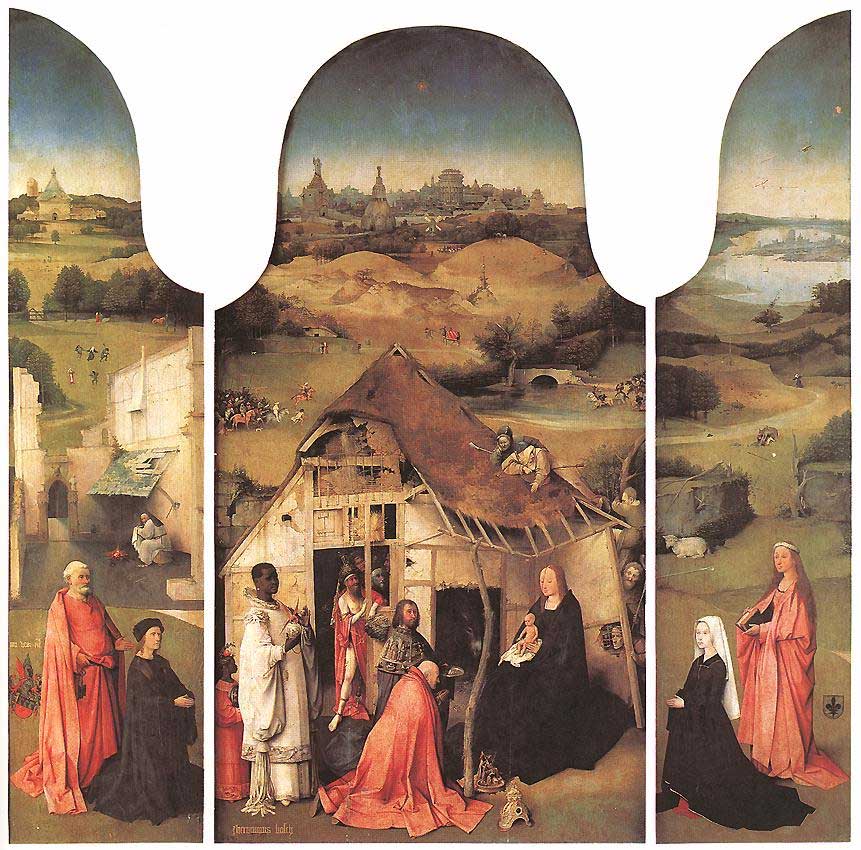Paintings

The Epiphany , Hieronymus Bosch
1475-1480
Oil on panel
74 cm × 54 cm (29 in × 21 in)
Museum of Art, Philadelphia
The Epiphany is an oil painting on wood panels triptych painted by Hieronymus Bosch around the year 1495. This triptych is also sometimes referred to as "The Adoration of the Magi". The centre panel measures 138 x 72 cm, and the wings measure 138 x 34 cm. The original version hangs in the Prado Museum in Madrid and another version (copy) in the Philadelphia Museum of Art, Philadelphia. It is not to be confused with the 74 x 54 cm Bosch painting of the name Epiphany, which may have been a working model for the triptych The Epiphany.
Exploration
The Adoration of the Magi altarpiece triptych, commissioned for Peeter Scheyve and Agnes de Gramme in 1495-1499, contains some elements which are unique to Bosch when compared with other Netherlandish triptychs. The central panel depicts the newborn Christ in Mary’s lap, with the three kings present. The ramshackle barn and insidious looking characters inside seem to invoke feelings from the viewer of looming danger. Two peasants look down from the roof; others try to catch a glimpse from holes in the barn wall or by climbing trees. The middle ground shows two of the kings’ followers riding toward each other as though entering battle against each other; a third cavalry rides closer to the city in the distance. The background of Jerusalem features a windmill in the center, a symbol which Bosch almost always incorporates in some way.
The flanking panels portray praying patrons with their namesake saints: Peter and Agnes. The side panels’ middle and foregrounds lack complete spatial continuity with the central panel, although they appear significantly similar enough to read the triptych as a panorama. Chronologically, the events of fore, middle, and backgrounds are concurrent throughout the panels. The three panels coherently run into one another; division due to the frame does not separate scene from scene or time differences.
Peter and the male patron appear on the left panel, which corresponds to Christ’s right side, the position of honour. Beyond them, Joseph dries linens by a fire.[1] Even though this is the only triptych of his that has a donor portrait, Bosch continues with the artistic norm in portrayal of donors. In the middle ground of this panel curious creatures inhabiting a field dance to bagpipes. Finally, the right panel has the female patron and saint, with a fleur-de-lis. A lamb, the emblem of St. Agnes, lies on the ground, above the praying woman. In the background, a woman flees on a road away from a wolf, while a man closer to the foreground cannot escape unfortunate demise at the jaws of another wolf.
When the hinged outer panels were closed (originally probably most of the time), a grisaille Mass of Saint Gregory is seen on their outside, also with a donor portrait.
Tradition of Netherlandish triptych painting
The Bosch Adoration differs from many other Northern Adoration triptychs by depicting the saints and donors on the same plane as Christ, but on the wings. Compared to his contemporaries, Bosch breaks with a common tradition of preserving each wing to be a separate event and chooses a continuous view. Bosch’s work possibly dates to about ten years before van der Goes, perhaps inspiring the Portinari altarpiece’s similar side panels of the donor in prayer on the wings with a saint. Memling’s St. John altarpiece also dates to the same time as the Portinari, but the scenes on the flanks are disconnected in theme from the center panel. One of Memling’s Adoration triptychs from before 1470 looks similar to the Columba in layout, using van der Weyden’s layout as opposed to the Portinari. An Adoration triptych known as The Pearl of Brabant,[2] by the younger Bouts lacks the continuous panels which van der Goes displays, putting Christopher and John the Baptist on the side panels in different settings than the Adoration scene. Historically, in addition to van Eyck, the elder Bouts used the wings of the triptych to act as extensions of the central space, but this occurs in different themed works since he never painted an Adoration. Two different approaches are common in the history of the Netherlandish triptych painting, and Bosch’s layout remains traditional in the general history of van Eyck and van der Goes, but strayed from the style imagined by van der Weyden and his subsequent followers such as Bouts.
Notes
1. ^ Laemers, Suzanne. "Hieronymus Bosch and the Tradition of the Early Netherlandish Triptych." Visual Culture: Images and Interpretations. Eds. Norman Bryson, Michael Ann Holly, and Keith Moxey. Hanover and London: Wesleyan University Press, 1994. 79
2. ^ Flügelaltar "Perle von Brabant"
From Wikipedia. Text is available under the Creative Commons Attribution-ShareAlike License
